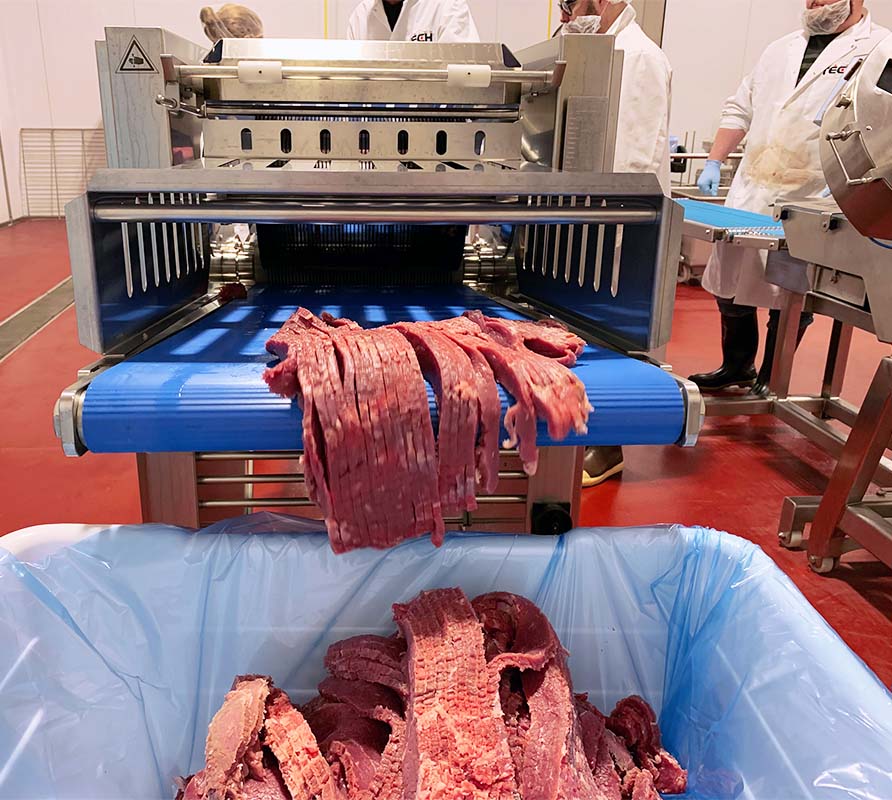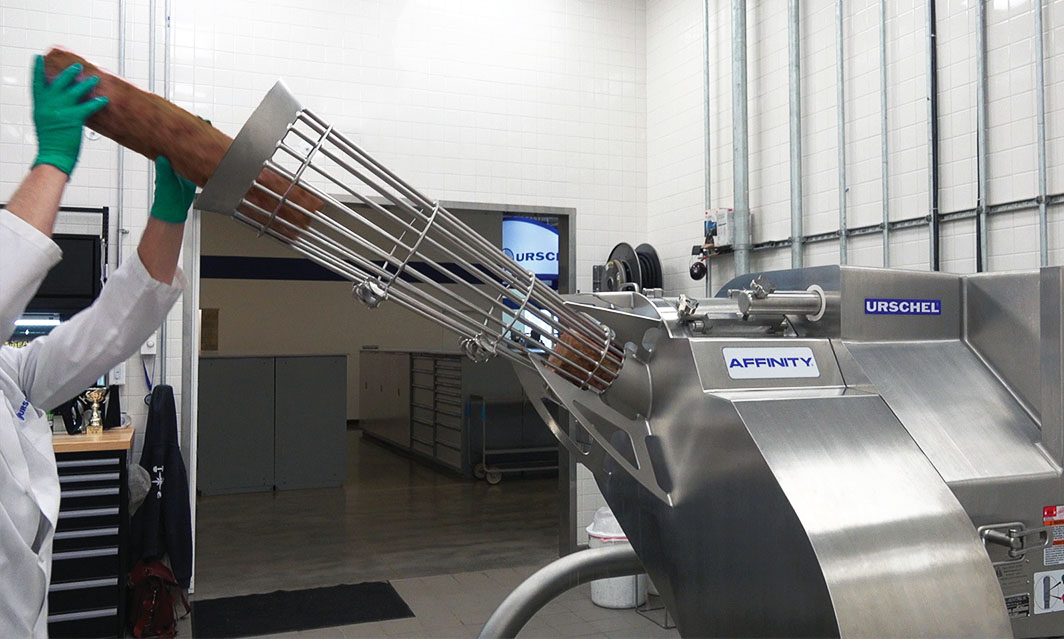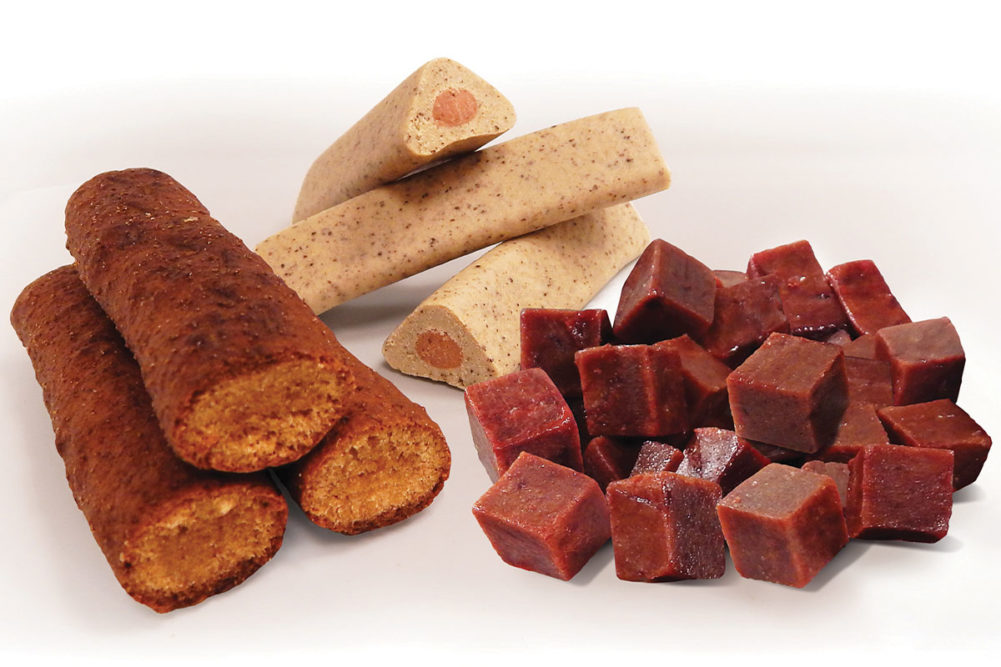This article was published in the December 2021 issue of Pet Food Processing. Read it and other articles from this issue in our December digital edition.
Dicers and slicers are indispensable in pet food and treat production. With a wide range of new and innovative products entering the market, these pieces of equipment are now used for a variety of different applications.
“Equipment that can handle both frozen and hot products is particularly important for pet food and treat processors,” said Nehemiah White, market manager, Deville Technologies, Saint-Laurent, Quebec. “Applications include reduction and dicing of frozen muscle meat and byproducts for freeze-dried treats (e.g., liver, lung, heart), dicing of hot, cooked products for canned and pouched foods, slicing of formed products for bagged treats, and reduction of refrigerated products for ready-to-eat meal products.”
“Equipment that can handle both frozen and hot products is particularly important for pet food and treat processors,” said Nehemiah White, Deville Technologies.
With more pet owners adopting a raw, fresh or frozen diet for their pets, the demand for food and treats made from fresh ingredients continues to rise. Dicers and slicers play a key role in processing these formats.
“Slicers (and dicers) are used on the raw side of pet treat processing, mainly for ‘whole muscle’ proteins, as well as vegetables,” explained Mike Maki, director of thermal processing, Fusion Tech Integrated, Roseville, Ill.
Dicers and slicers often process the premium ingredients for wet pet foods, freeze-dried products and popular single-ingredient dried treats, all trends that manufacturers are embracing.
 Uniform slice thickness ensures products dry or dehydrate evenly, making the overall processing more efficient. (Source: FusionTech)
Uniform slice thickness ensures products dry or dehydrate evenly, making the overall processing more efficient. (Source: FusionTech)
“Urschel has fresh veggie cutting applications such as reducing sweet potatoes into dices, strips or slices for making freeze-dried and dehydrated dog treats as well as additives for different meat and veggie pet food mixes,” said Mike Jacko, vice president of applications and new product innovation, Urschel, Chesterton, Ind. “We also dice meats for freeze-dried meat snacks, and shred cooked whole muscle and processed meats for high-end cat and dog foods.”
Slicers are commonly used to maintain consistent slicing thickness prior to smoking, cooking or drying.
“Because the product must be extremely dry for shelf life, differences in thickness are a huge problem due to long drying times,” Maki said. “If you have to ‘re-cook’ the thicker pieces, you are tying up additional oven production time.”
In addition, dicing and slicing equipment is used to reduce the size of continuously extruded product.
“As product exits an extrusion head, processors are placing slicers inline to cut the extruded product into pet treat sticks,” commented Bill Williams, product line manager, slicing, dicing, shredding and volumetric filling, Marlen, Riverside, Mo.
Needs and challenges
Modern dicers and slicers must be incredibly versatile due to the huge variety of pet food and treat products on the market, as well as the growth of the industry as a whole.
 In this application, extruded treats are cut to an initial length then further reduced to lengths that perfectly fit the packaging. (Source: Sosland Publishing Co.)
In this application, extruded treats are cut to an initial length then further reduced to lengths that perfectly fit the packaging. (Source: Sosland Publishing Co.)
“The need for versatility of cutting equipment is critical for brands to address the dynamic nature of the industry’s growth needs,” White said. “The ongoing supply chain and labor challenges have created an environment that is disrupting the ability of manufacturers to produce the incredible volumes necessary to meet the growing demand, which leads to the absolute necessity of high capacity cutting equipment that will not only stand up to the 24/7 production schedules but also continue to produce high-quality product over the long term. Due to these factors, automation and smart integration with new and existing production environments is non-negotiable and essential to ensuring continuous operations that can weather the dynamic world of pet food.”
The physical properties of certain ingredients also present challenges for dicing and slicing equipment.
“Some applications, such as hard frozen meats like liver or lung at subzero temperatures for freeze-drying, may present some challenges,” Jacko explained. “It may present risks such as damaging knives or breaking belts, for example. Urschel takes the time to analyze each application and work with customers to overcome obstacles. Extruded products, in comparison, are usually cut at hotter, higher temperatures, so that presents different challenges. A good place to start with these applications is a free-of-charge test cut. Test cutting is available in-person, live remotely, or via video.”
Maki agreed that the wide range of ingredients used in pet food and treat production presents several challenges for processors.
“The main issue facing our customers is all the different types of treats,” Maki said. “If they are slicing whole muscle (chicken breast, pork, beef, etc.), they need a certain type of slicer. However, if they have to dice the product prior to cooking (such as meat or vegetables), then they need a completely different slicer or dicer. If they are extruding a mixture of ingredients into strips, then they need different equipment for that, including stuffers and extruders.”
New technology and solutions
Manufacturers of dicing and slicing equipment are expanding their capabilities to handle an increasing variety of ingredients, as well as ensure systems offer greater reliability and performance.

“Deville has been addressing these industry concerns through a holistic approach to process improvement,” White explained. “Rather than a piecemeal approach of developing or improving individual equipment, we have developed a systematic framework that ensures the entire production stream is optimized. This approach has enabled us to develop fully integrated systems to automate everything from raw product receipt to precise dispensing post-reduction. These integrated cutting systems include versatile, robust, high-capacity cutting equipment that will support the ongoing growth of the industry.”
In recent years, a number of advancements in dicing and slicing technology have led to better sanitation, higher capacity, and a more user-friendly experience.
“Urschel is always looking for new applications, always making continuous advancements in cutting machinery to be more modern, high capacity, more user friendly, and increase sanitary features,” Jacko said. “Our USDA accepted Affinity Dicer is becoming the go to machine in freeze-dried and hot extruded applications for pet food. New on the Affinity is a built-in precutter – this offers an all-in-one solution to assist in the processing of logs.”
Improved software and user interfaces are also playing an important role in increasing capability.
“The newest technology available for dicers and slicers is 4.0 software that continuously monitors, reports, and dynamically supports the operational efficiency and parts supply needs of cutting equipment,” White said. “Deville’s newly released software platform, Deville Digital, is a perfect example of such technology. Additional technology includes robust, high-capacity block breakers (or cubers) that reduce full blocks of frozen meat and meat by-products for downline precision dicing and high-quality knife sharpeners that decrease overall blade cost and ensure a strong supply of blades.”
In some cases, however, simplicity is winning out over technology. Maki said many of Fusion Tech’s customers like simplicity and favor mid- to low-technology slicers and dicers as an economical option both for initial investment and for ongoing equipment cleaning and maintenance costs.
 Test cuts of products prior to purchase provide proof of a dicer or slicer’s ability to handle each unique application. (Source: Urschel)
Test cuts of products prior to purchase provide proof of a dicer or slicer’s ability to handle each unique application. (Source: Urschel)
Sanitation and maintenance
Dicers and slicers have evolved over the last few years from a maintenance and sanitary design standpoint. The onus is on equipment manufacturers to make equipment that is simple to clean, operate and maintain.
“As with all food manufacturing, hygienic equipment design is paramount,” Williams said. “Marlen has really set the standard for open hygienic frame design by replacing hollow tube welded frames with open channel stainless steel frames for complete wash down.”
When it comes to maintenance, keeping blades sharp is crucial to ensuring consistent throughput and quality.
“Knives are at the heart of every machine, and should be replaced on a routine basis,” said Mike Jacko, Urschel.
“Knives are at the heart of every machine, and should be replaced on a routine basis,” Jacko said. “A high-capacity machine running fast with dull blades will not deliver the correct in-spec product. The shafts and bearings should also be maintained optimally and replaced as necessary. When blades become dull, they obviously don’t cut easily, so it creates more pressure on the equipment drives, thereby requiring parts and motors to be replaced more frequently.”
Preventative maintenance (PM) schedules can help keep cutting equipment in peak performance.
“For particularly rough applications cutting frozen or hard products and in processes requiring high precision, it is important to develop a daily blade check SOP in addition to keeping a high-quality blade sharpener available to help manage the cost of blades,” White said. “Manufacturers can keep their cutting equipment in peak performance by developing daily, weekly and monthly PM schedules to inspect and repair any mechanical (gears, belts, lubrication) or cutting zone components (blades, shafts, bearings).”
Find more articles about the latest pet food processing technologies on our Equipment page.




